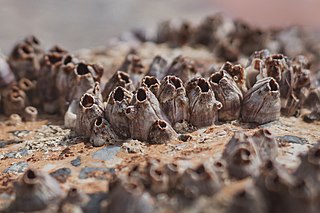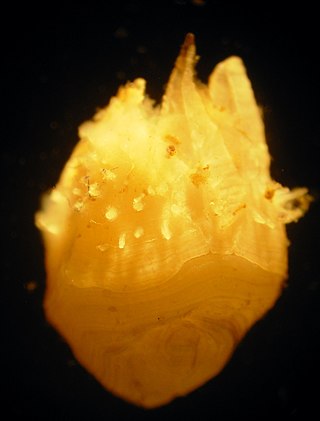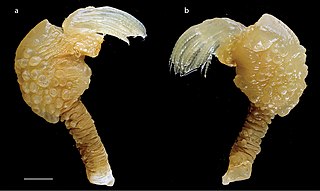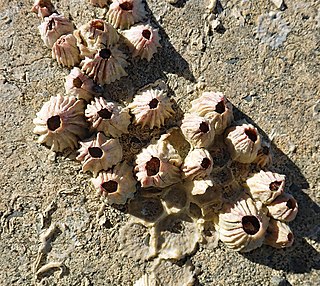
Balanus is a genus of barnacles in the family Balanidae of the subphylum Crustacea.

Acasta is a genus of barnacles in the family Balanidae, containing the following species:
Calantica is a genus of barnacles in the family Calanticidae, containing the following species:
Conopea is a genus of barnacle, containing the following species:

Paralepas is a genus of goose barnacles in the family Heteralepadidae.
Oxynaspis is a genus of goose barnacles in the order Lepadiformes.

Verrucomorpha is an order of asymmetrical sessile barnacles in the class Thecostraca. They are typically found in deeper and deep-sea habitats. There are 2 families and more than 100 described species in Verrucomorpha.

Epopella is a genus of symmetrical sessile barnacles in the family Tetraclitidae. There are about six described species in Epopella.

Notomegabalanus is a genus of acorn barnacles in the family Balanidae. There are about 12 described species in Notomegabalanus.

Notobalanus is a genus of acorn barnacles in the family Balanidae. There are at least two described species in Notobalanus.

Chirona is a genus of acorn barnacles in the family Balanidae. There are about six described species in Chirona.
Hoekia is a genus of coral barnacles in the family Pyrgomatidae. There are at least four described species in Hoekia.

Microlasma is a genus of symmetrical sessile barnacles in the family Pachylasmatidae. There are at least four described species in Microlasma.

Eurylasma is a genus of symmetrical sessile barnacles in the family Pachylasmatidae. There are at least three described species in Eurylasma.

Eutomolasma is a genus of symmetrical sessile barnacles in the family Pachylasmatidae. There are at least four described species in Eutomolasma.

Tetrapachylasma is a genus of symmetrical sessile barnacles in the family Pachylasmatidae. There are about five described species in Tetrapachylasma.

Pachylasma laeviscutum is a species of symmetrical sessile barnacle in the family Pachylasmatidae.

Triangulus is a genus of parasitic barnacles in the family Triangulidae, the sole genus of the family. There are at least four described species in Triangulus.

Waikalasma is a genus of symmetrical sessile barnacles in the family Waikalasmatidae, the sole genus of the family. There are at least three described species in Waikalasma.















